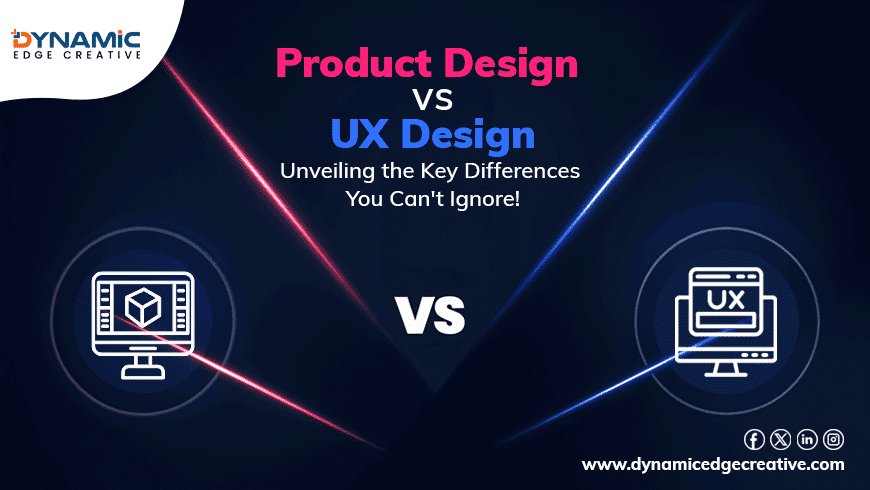
Curious about the buzz around Product Design and UX Design? If you are looking to improve your business’s digital products, you have to understand these two critical disciplines which is really important.
Product Design and UX Design might seem similar. But they each play a different role in crafting memorable user experiences. Imagine you are designing the latest app or an advanced gadget. What makes it stand out?
Is it the sleek aesthetics or the smooth interaction? This read explains the differences between Product Design and UX Design and explores how they complement each other.
What is Product Design?
Product Design is focused on creating and refining digital and physical products that meet user needs and business goals. It involves conceptualizing, designing, and optimizing products. It may include websites, apps, and tangible goods.
Product Designers integrate elements of visual design and user experience to ensure products are aesthetically pleasing and user-friendly.
What is UX Design?
UX Design focuses on improving the overall experience users have with a product. It involves understanding user needs, behaviors, and pain points. So that they can create intuitive and efficient user interactions.
UX Designers conduct user research and develop wireframes and prototypes. They also test usability to ensure that digital products are easy to navigate and meet user expectations.
Core Differences between Product Design and UX Design
Product Design and UX Design are closely related. But since, they differ in their focus and scope.
Product Design covers the entire lifecycle of a product, from conceptualization to final execution. It involves creating both physical and digital products with a focus on overall functionality and market appeal.
A Product Designing Company will consider user needs, business goals, and technical feasibility. Also the product’s market fit really matters. These altogether ensure the product is desirable and viable.
In contrast, UX Design is aligned on the user interaction with the product. It focuses on understanding user behavior and pain points.
UX Designers focus on the digital aspects of a product. It may include navigation, usability, and user satisfaction. Their primary goal is to ensure the product is easy to use. This may lead to better engagement and customer loyalty.
Product Design is holistic and covers all aspects of a product. UX Design and Development focuses on optimizing user interaction.
How Product Design and UX Design Interact
Product Design and UX Design are closely interconnected. They often overlap in their goals and processes. Product Design focuses on the vision and execution of a product. UX Design improves on the user experience within the digital setting.
The interaction between these two disciplines is important to creating a visually appealing product. Product Designers and UX Designers collaborate closely and share insights and feedback throughout the development process.
They ensure the product aligns with user needs and business objectives. This collaboration ensures that every aspect of the product, from its look and feel to its usability contributes to a smooth and satisfying user experience.
Skills and Expertise Required
Product Designers need a broad skill set. It covers various aspects of design, engineering, and business strategy. They must be proficient in visual design, typography, color theory, and layout, as well as possess a deep understanding of user-centered design principles. Additionally, they need to be familiar with manufacturing processes, materials, and prototyping.
On the other hand, UX Designers require a strong foundation in user research, interaction design, and information architecture. They must be skilled in creating wireframes and prototypes and conducting usability tests to ensure the product meets user expectations. Empathy and an understanding of user psychology are crucial, as UX Designers need to anticipate and address user needs and pain points.
Real-World Applications and Examples
In real-world scenarios, the interplay between Product Design and UX Design can be seen in the development of successful products like the iPhone or Tesla vehicles.
For instance, Apple’s approach to the iPhone’s design combines sleek aesthetics with an intuitive user interface. It results in a visually appealing and easy to use product.
Similarly, Tesla’s electric cars showcase a smooth integration of advanced technology with a user-friendly interface. As a whole it enhances the driving experience.
Amazon’s e-commerce platform uses UX design to create an intuitive shopping experience with personalized recommendations and one-click checkout features. The product design integrates these experiences across devices to ensure consistency and ease of use.
Choosing the Right Design Approach for Your Project
Deciding between Product Design and UX Design, or how to balance both, depends on the specific needs of your project.
If your focus is on creating a product that requires a cohesive integration of physical and digital elements, Product Design should be your primary focus. It has a strong focus on market appeal and functionality.
If your project revolves around optimizing the user’s interaction with a digital product, then UX Design will be preferable. This will ensure ease of use and satisfaction.
The best approach often involves a combination of both disciplines. This ensures that the product is well-designed and also delivers an exceptional user experience. By understanding the strengths of each discipline, you can choose the right approach that aligns with your project’s goals and target audience.
Bottom Line
Understanding the nuances between product design and UX design is important for anyone looking to start a career in a respected field. So, decide which path resounds with you. Whether you are shaping the entire product or crafting smooth user experiences, both disciplines are vital in creating successful digital products.
Frequently Asked Questions
Please go through these FAQs so we can get to business quickly.
Product design focuses on creating and refining a product’s overall experience, including its functionality, aesthetics, and user interaction, to meet user needs and business goals.
UX design emphasizes enhancing the overall user experience by understanding user behavior, preferences, and pain points to create intuitive and engaging digital interfaces.
Product design covers the entire lifecycle of a product, while UX design specifically concentrates on optimizing the user’s interaction and experience with the product.
